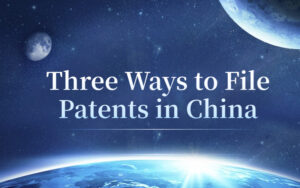Types of Patents and Dual Filing Strategy in China
This article will discuss three types of patents in China and the dual filing stratege for filing inventions and utility model patents.
Types of Patents in China
China’s patent law allows inventors and companies to file one of three types of patents: invention, utility model, and design. First, let’s have an overview of the three types of patents in China.

The US applicants are more familiar with invention and design patents. According to the data released by the China National Intellectual Property Administration (CNIPA)[1], during the first quarter of 2022, CNIPA granted 766,957 utility model applications, among which 99.7% (764,724) of the utility model applications were filed by Chinese applicants. Foreign applicants filed only 2,233 utility model applications, which is just 0.3% of the total. While for invention patent applications, a total of 23,988 applications were filed by foreign entities, which is about 14.9% of the total number of invention patent applications filed in China.
In other words, most foreign applicants choose to file invention applications rather than utility model applications in China. One reason is that utility model applications have a shorter term of protection and a limited scope of subject matters. Another possible reason is that foreign applicants, particularly those from countries where no similar system exists, are simply unfamiliar with Chinese utility models.
Pros and Cons of Utility Models
The pros of utility models in China
The registration of a utility model patent is much faster than that of an invention patent. A utility model patent can be granted within 6-12 months. In addition, utility model patents have a lower inventiveness requirement. For utility models, examination is simplified. Naturally, the costs for obtaining and maintaining a utility model patent are substantively cheaper.
The cons of utility models in China
First, the utility model is only available to products with definite shape, structure and the combination thereof. That is to say, it protects limited subject matters. Second, as we mentioned above, it has a shorter protection term. And finally, the enforcement of a utility model may face more uncertainties given that it is granted without a substantive examination.
Generally speaking, utility models can be a quick and cost-efficient way to protect products with a short life cycle. Invention patents may not be desirable for products with short life cycles because prosecution can take several years and can be costly to maintain. In contrast, utility models can provide protection for these products at much earlier stage and are cheaper to obtain and maintain.
Dual Filing Strategy
What is the dual filing strategy?
A strategy for filing patents in China could include filing invention and utility model applications at the same time. This means that the same technology could be filed with two applications: one as an invention, the other as a utility model.
Once the utility model patent is granted, the prosecution of the invention patent may be allowed to continue. If the invention patent is subsequently allowed for the same subject matter, the examiner will request that the applicant select between the utility model patent and the invention application. The applicant will usually abandon the utility model patent and take the invention patent for protection to have a longer patent term.
What is the advantage of dual filing strategy?
Through this dual filing practice, the patent owner can enjoy the benefits of fast issuance of the utility model patent, as well as the advantage of longer-term protection of the corresponding invention patent on the same subject matter, if granted. However, the examination of the invention may be delayed if it is filed simultaneously with the utility model.
It should be noted that to take advantage of the “dual filing” strategy, the two applications should be filed on the same date. If the applications are filed on different days, or have different priority dates, the earlier-filed application or the application with an earlier priority date will constitute prior art against the latter filed application.
Both Paris Convention and PCT route are allowed to file utility models in China. For the route of Paris Convention, the dual filing strategy is available. However, the dual filing strategy is not available for PCT applications. At the time of national phase entry, you may choose to file an invention or a utility model based on the PCT application, but not both.
Conclusion
The Chinese utility model system can be used to strategically enhance the scope of patent protection in China. Should you have more questions regarding types of patents and filing strategies in China, please contact us.

